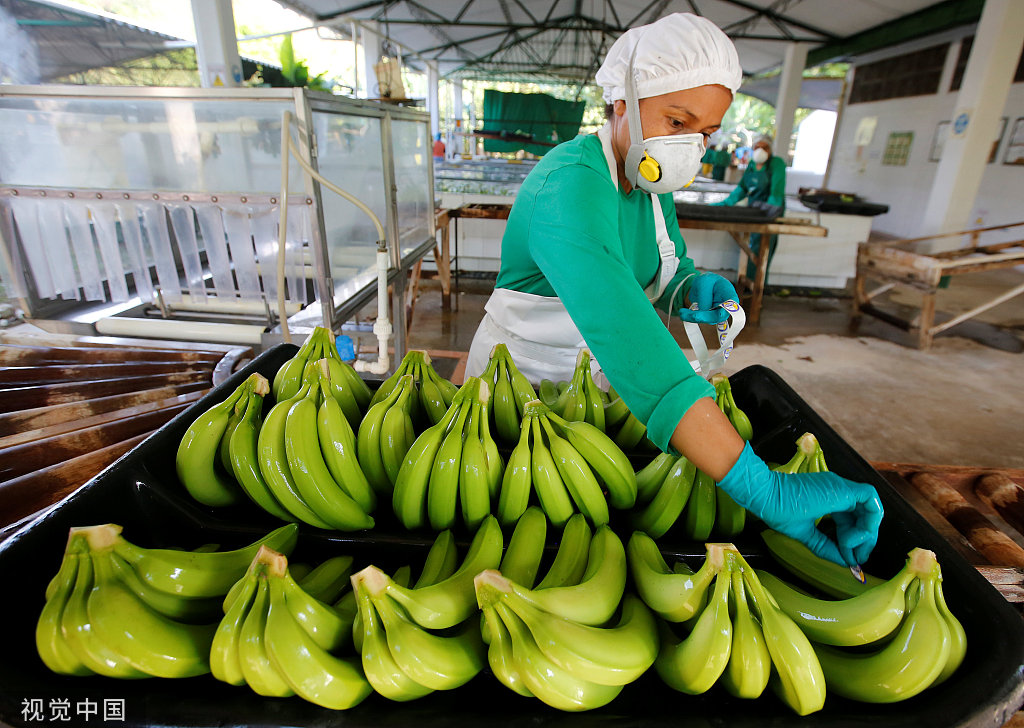Fungus hits banana crops in Colombia
By Sergio Held in Bogota, Colombia | China Daily | Updated: 2019-08-16 09:35

Panama disease outbreak comes as nation hopes to expand China exports
Colombia has declared a national emergency after confirming a fungus outbreak infecting bananas in the north of the country. It came at a tricky time for Colombia, as it works to diversify its export markets and eyes China as a key destination.
Originating in East Asia, the fusarium R4T fungus causes a blight known as Panama disease. After appearing in the Middle East and Africa in 2013, it has now made the leap to Latin America. It was found in six plantations across 175 hectares in the La Guajira department, a region bordering Venezuela, according to the Colombian Agricultural Institute, or ICA.
The disease does not affect human beings, is not transmitted through the fruit itself and is unlikely to pose a danger to importing countries. The danger is that it can destroy entire crops and thus the livelihoods of about 700,000 families in Colombia that depend on banana and plantain production.
The fungus has so far hit about 7 percent of La Guajira's banana production, and authorities want to ensure the damage is contained to the area. The main goal is to prevent the fungus from spreading to the nearby departments of Magdalena, Cesar or, worse, elsewhere on the continent.
Jose Francisco Zuniga, executive president of the Banana Growers of Magdalena and La Guajira Association, or Asbama, said that it is difficult to pinpoint how the fungus arrived in Colombia.
"We know it can be spread by shoes or machinery, but it is now up to ICA to define how it entered and where it came from," Zuniga said.
Jaime Cardenas, deputy manager of plant protection at ICA, said the fungus likely entered Colombia in soil or contaminated plant material brought in from other countries where the disease is active.
"We also work on the hypothesis of machinery or vehicles contaminated with soil waste, as a possible way of entry," Cardenas said. "To date, 168.5 hectares have already been eradicated, and we have strengthened bio-safety measures to avoid the spread of the fungus.
The government is concentrating containment efforts on three fronts: intervention on farms; control of mobilization; and implementation of controls at ports, airports and border crossings.
In late July, Colombian President Ivan Duque Marquez made a state visit to China and secured a commitment from Beijing to purchase $40 million worth of Colombian bananas.
With this deal, "bananas will perhaps be the main agricultural export product to the Chinese market," Duque said in Shanghai on July 30.
He added that the move will address Colombia's trade deficit with China. "Forty million dollars more in the trade balance means, practically, closing the gap that we have in the agricultural sector with this country," Duque said.
Uniban, Colombia's largest banana and plantain exporter, will be among the companies spearheading the new banana deal with China. The company accounts for about 4 percent of global banana exports and its crops are located in the Uraba region, hundreds of kilometers from La Guajira.
Augura, Colombia's association of banana growers, expects the emergence of the disease to have a limited impact on the country's exports.
"We knew that this disease could reach Colombia, as it has in other countries, which have managed to control it while continuing exports and growing economically," said Emerson Aguirre, Augura's interim president. "The main target is to prevent its spread to other farms and regions of the country."
Augura is confident about the opportunities the Chinese market can bring to the banana sector.
"This is the beginning of a very good relationship, which we hope to be prosperous and lasting, since reaching countries like China will generate many more opportunities, jobs, as well as the contribution to the consolidation of the Colombian economy," said Aguirre.
Sixth-largest exporter
In 2018, Colombia was the world's sixth-largest banana exporter, having shipped $859 million worth of bananas, mostly to the United States and Europe. That figure accounted for about 3 percent of the country's exports and 6.4 percent of global banana exports.
Banana production in the Magdalena, La Guajira and Cesar departments has grown significantly since 2016, at a rate of about 80,000 additional tons per year. "We went from 520,000 tons in 2016 to 680,000 last year," said Zuniga of Asbama.
Colombia has already stepped up bio-safety measures at the key port of Santa Marta, located on the Caribbean coast of the country.
"Facing the possibility of mechanical transmission (of the fungus) by dirty containers, the measures of extraction, cleaning and disinfection of the containers in the port of Santa Marta have been taken and checkpoints have been installed for this purpose," said Cardenas.
As the fungus is not transmitted in the fruit, with the right precautions it should not affect export destinations.
Despite the outbreak, Colombia is now working to extend the number of approved production areas for exports to China. In July, a Chinese delegation visited the Magdalena banana zone in the north of the country.
China is the fourth-largest banana importer in the world after the US, Europe and Russia, according to the Food and Agriculture Organization of the United Nations. China imported about 1.2 million tons of the fruit last year.
China's main banana suppliers are the Philippines and Ecuador, which borders Colombia. Ecuador supplies about 23 percent of the global banana market and is now watching how Colombia copes with the blight.
According to health agencies, if unchecked, the fungus can spread around 100 kilometers per year. Ecuador is about 1,300 km from La Guajira.
The author is a freelancer for China Daily.
























